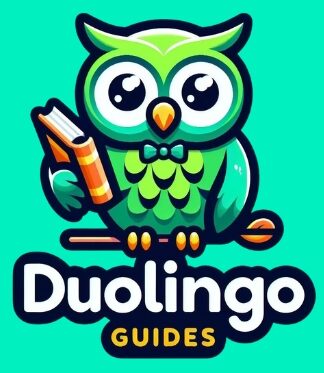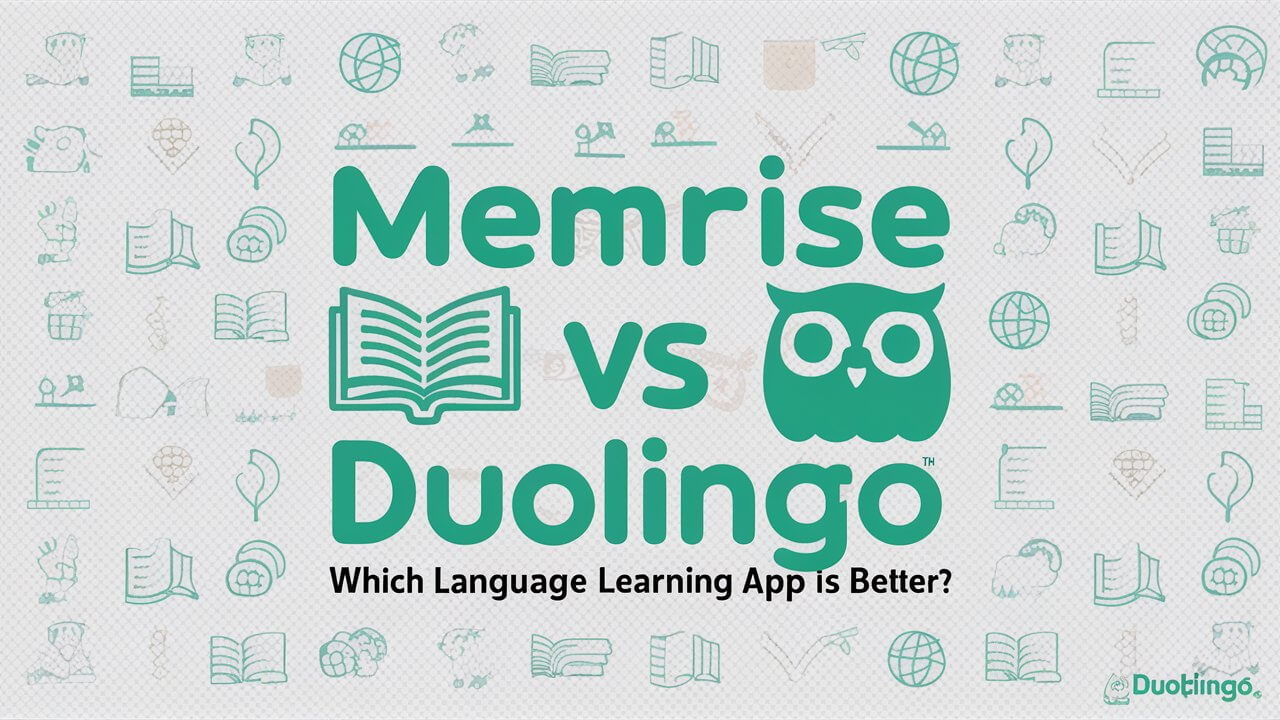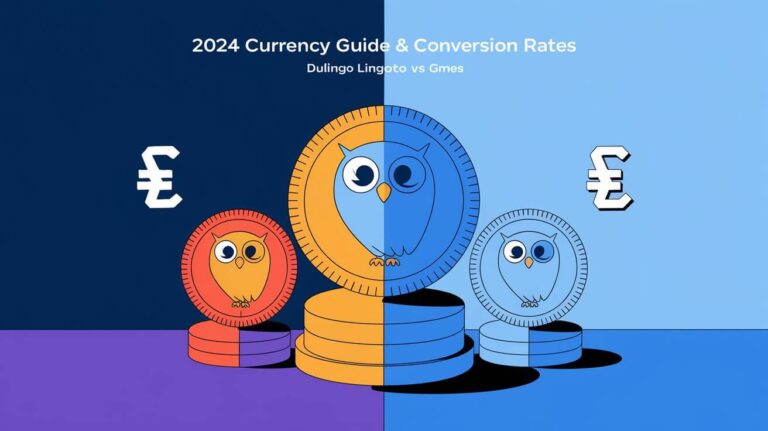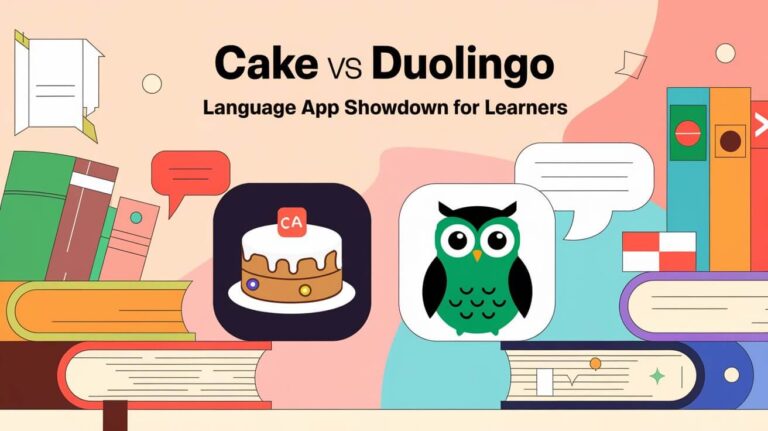In the world of language learning apps, Memrise and Duolingo are top choices. They each have their own way of teaching new languages. This guide will show you the main differences between these two apps.
Memrise focuses on learning vocabulary with spaced repetition and native speaker videos. This makes learning feel more real. Duolingo, on the other hand, offers lessons in over 40 languages. It uses games to make learning quick and fun, lasting just 5-10 minutes.
Both apps have free versions and premium subscriptions. Memrise’s Pro plan costs $23 a month. Duolingo’s Super Plan is about $12.99 a month or $59.99 a year. Your choice will depend on what you need to learn and how you like to learn.
Platform Interface Comparison
Both Memrise and Duolingo offer apps for mobile and desktop. This lets users learn on the move or at home. But, the experience can differ between devices.
Mobile App Experience
Memrise’s app lets users choose their study time. They can pick from short 5-minute sessions to longer 30-minute ones. This suits different schedules and learning styles. Duolingo, though, sticks to 5-10 minute lessons. This might be better for daily practice.
Desktop Platform Features
Memrise’s desktop version includes more videos with native speakers. This makes learning feel more real and engaging. Duolingo, on the other hand, focuses on fun elements like points and leaderboards. This appeals to those who enjoy a competitive learning environment.
User Interface Design
The design of both apps affects how users learn. Memrise has a simple, clean design. This helps users focus on the content. Duolingo, with its bright colors and animations, offers a more lively learning experience.
Choosing between Memrise and Duolingo depends on what you prefer. Do you want flexibility, immersion, or gamification in your learning? The right choice will match your learning style.
Language Course Selection and Availability
Memrise and Duolingo offer a wide range of language courses. Memrise has over 23 languages, including Spanish, French, and German. It also has unique options like conlangs and endangered languages.
Duolingo provides lessons in more than 30 languages. This gives users many choices to learn and master. Both apps are known for their quality content, making them great for beginners.
Memrise stands out with its user-created courses. These cover local sports, culture, and specific interests. This customization is great for those who want a more personal learning experience.
Duolingo and Memrise both offer a broad selection of languages. Your choice depends on your preferences and what you want to achieve in learning a language.
Lesson Structure and Duration
Language learning apps have different lesson structures and durations. Memrise and Duolingo offer bite-sized lessons, but they differ in some ways.
Daily Time Commitment
Memrise lessons last 10-15 minutes. This makes it easy to fit language practice into your daily routine. Duolingo, on the other hand, offers lessons that are 5-10 minutes long. This is great for those who prefer shorter, more frequent practice sessions.
Learning Path Organization
Memrise uses videos of native speakers to immerse users in the language. Duolingo focuses on text and audio exercises like fill-in-the-blanks and translations.
Progress Tracking Methods
Memrise uses adaptive technology to tailor the learning path to each user. Duolingo has a more structured approach, where sections are unlocked after completing the previous ones.
| Feature | Memrise | Duolingo |
|---|---|---|
| Lesson Duration | 10-15 minutes | 5-10 minutes |
| Lesson Content | Videos of native speakers, adaptive learning | Text-based and audio-based exercises |
| Progress Tracking | Adaptive technology to personalize learning | Rigid structure with locked sections |
Free vs Premium Features
Language learning platforms like Memrise and Duolingo have free versions with basic features. But, premium subscriptions open up more content and tools for a deeper learning experience.
Memrise’s Pro Plan gives you access to over 20 languages. It includes personalized lists, native speaker videos, and advanced learning techniques. Duolingo’s Super Plan removes ads and adds more exercises, tracking, and the chance to learn many languages at once.
The free versions are good for basic learning. But, premium subscriptions unlock more. Memrise Pro offers a deep, personalized journey. Duolingo Super is great for those who like games and a wide range of features.
| Feature | Memrise Free | Memrise Pro | Duolingo Free | Duolingo Super |
|---|---|---|---|---|
| Access to all languages | ✓ | ✓ | ✓ | ✓ |
| Personalized vocabulary lists | ✓ | ✓ | ✓ | ✓ |
| Native speaker videos | ✓ | ✓ | – | ✓ |
| Spaced repetition | ✓ | ✓ | ✓ | ✓ |
| Gamified learning experience | ✓ | ✓ | ✓ | ✓ |
| Progress tracking | ✓ | ✓ | ✓ | ✓ |
| Ad-free experience | – | ✓ | – | ✓ |
Opting for the premium plans of Memrise or Duolingo offers a more enhanced learning experience. Your choice depends on what you need and how you like to learn. Both platforms have their strengths.
Pricing Models and Subscription Options
When comparing memrise vs duolingo cost, you’ll find different pricing plans. Babbel vs duolingo also has varying costs. Knowing the subscription options helps you pick the right one for your language learning.
Monthly Plans Comparison
Memrise Pro Plan costs $23 a month for full access. Duolingo’s Super Plan is $12.99 a month. If you’re looking for a cheaper option for a short time, Duolingo might be better.
Annual Subscription Benefits
Both Memrise and Duolingo give discounts for yearly subscriptions. Memrise’s yearly plan is $94, and Duolingo’s is $59.99. These plans are great for those who plan to learn for a long time.
Lifetime Access Options
Memrise has a lifetime access option for $250. This is a good deal for serious learners who will use the platform a lot over the years.
Choosing between memrise vs duolingo cost or babbel vs duolingo depends on your goals, budget, and how long you want to learn. Both platforms have flexible pricing to meet different learner needs.
Teaching Methods and Learning Approach
Duolingo and Memrise are two popular apps for learning languages. They have different teaching methods and learning approaches. Both aim to make learning fun and effective, but they do it in different ways.
Memrise uses spaced repetition and adaptive technology to tailor learning to each user. It helps users remember words and phrases by repeating them. It also uses AI to focus on areas where users need more practice. Plus, it includes videos of native speakers to improve pronunciation and cultural understanding.
Duolingo takes a more game-like approach to learning languages. It has structured lessons and various exercises to keep users interested. Duolingo uses text and computer voices for pronunciation, not real native speakers.
Memrise and Duolingo each have their own strengths. Memrise is great for those who want to remember words and use them in real life. Duolingo is better for those who enjoy interactive and fun learning experiences.
| Memrise | Duolingo |
|---|---|
| Spaced repetition and adaptive technology | Gamified lessons and diverse exercise types |
| Emphasis on vocabulary retention and real-world language use | Focus on interactive and engaging language learning |
| Incorporation of native speaker videos | Primarily text-based lessons and computer-generated audio |
Deciding between Memrise and Duolingo depends on your preferences and goals. Both apps offer effective ways to learn a language.
Native Speaker Integration
Learning a language is better when you hear native speakers. Memrise stands out here. It uses videos of native speakers to teach you. You get to see body language and how they talk naturally.
Video Content Quality
Memrise’s videos are top-notch. They show native speakers in different situations. This makes learning feel real and immersive. Duolingo uses computer voices, which isn’t as good.
Audio Pronunciation Features
Memrise lets you hear native speakers and record yourself. You can then compare your voice to theirs. This helps you improve your accent and sound more natural. Duolingo doesn’t offer this, which might make your language skills less natural.
Memrise’s use of native speakers and interactive tools makes it better than Duolingo. It gives you a more real and engaging way to learn a language.
Vocabulary Building Techniques
Memrise and Duolingo have different ways to help you learn new words. Memrise uses spaced repetition and adaptive technology. This helps move words from short-term to long-term memory.
Memrise lets you mark words as known or hard. This makes learning fit your needs. You spend more time on tricky words, which helps you remember them better. Duolingo uses exercises to teach vocabulary, but it repeats simple words a lot.
| Feature | Memrise | Duolingo |
|---|---|---|
| Vocabulary Focus | Strong emphasis on vocabulary acquisition through spaced repetition and adaptive learning | Introduces vocabulary through exercises, with more frequent repetition of basic words |
| Personalization | Allows users to mark words as known or difficult, customizing the learning experience | Follows a more standardized approach, with less personalization options for vocabulary |
| Vocabulary Variety | Offers a diverse range of vocabulary content, including specialized and nuanced terms | Focuses on building a solid foundation of common vocabulary terms |
Memrise and Duolingo are both great for learning languages. But they teach vocabulary in different ways. Memrise is great for those who want to learn lots of words. Duolingo is good for those who like a more structured learning path.
Grammar Instruction Effectiveness
Memrise and Duolingo take different paths in teaching grammar. Memrise dives deep into grammar rules and sentence structure early on. Duolingo, on the other hand, teaches grammar through contextual exercises, not explicit rules.
Grammar Rule Presentation
Memrise is clear about its grammar lessons, covering many rules and structures. Users can review these lessons anytime to solidify their understanding. Duolingo, by contrast, blends grammar into its lessons, focusing on practice and sentence patterns.
Practice Exercise Types
- Both Memrise and Duolingo offer various exercises to practice grammar, like sentence building and translation.
- Memrise focuses on structured exercises with clear rules. Duolingo’s approach is more flexible, integrating grammar into its lessons.
- The best app for grammar instruction depends on the learner’s style and the language they’re learning.
Memrise vs Duolingo: Direct Comparison
Memrise and Duolingo are top choices for learning languages. They each have unique strengths for different learners. Let’s compare them closely.
Memrise shines with native speaker videos for a real learning feel. You can adjust lesson lengths to fit your pace. It’s known for helping you remember words well.
Duolingo, on the other hand, offers more languages, over 40. It makes learning fun with points and challenges. This makes learning a game.
Memrise is praised for its natural language use. But Duolingo sometimes uses phrases that feel a bit off. Yet, both apps have their own strengths for different learners.
Memrise costs $14.99 a month, while Duolingo’s premium is $12.99. Memrise also has a money-back guarantee, something Duolingo doesn’t offer.
The choice between Memrise and Duolingo depends on your specific goals and learning preferences. Both are great tools for learning a new language.
Community and Social Features
Language learning apps often include community and social features to improve the user experience. Memrise and Duolingo have different ways to meet their users’ needs.
Memrise is known for its community focus. Users can make and share their own courses. This offers a wide range of topics and dialects not found in the app’s standard courses. It lets users connect and work together, creating a sense of community.
Duolingo, on the other hand, uses gamification to add social elements. It has leaderboards and friend challenges to encourage competition. This keeps users motivated and practicing their languages.
Memrise and Duolingo have different community philosophies. Memrise focuses on user content and collaboration for a personalized experience. Duolingo’s approach is more about competition and gamification to keep users engaged.
The decision between Memrise and Duolingo depends on your learning style. If you like working together and creating content, Memrise might be for you. If you enjoy competition and games, Duolingo could be the better choice.
Progress Assessment and Testing
Memrise and Duolingo both have great tools for checking how well you’re doing. Memrise uses smart tech to see how good you are and change the lessons to fit you better. This keeps you learning at your own pace and makes sure you’re always getting a challenge.
Skill Level Evaluation
Memrise keeps an eye on how you do and changes your lessons on the fly. It finds out what you’re good at and what you need to work on. Duolingo, on the other hand, has levels you move through as you get better. You unlock new things as you show you know your stuff.
Achievement System
Both memrise vs duolingo for languages and memrise vs duolingo japanese make learning fun. Memrise gives you points and badges when you finish lessons. Duolingo has points and rewards too, to keep you coming back for more. These systems make you feel like you’re getting somewhere, which is great for learning a new language.
| Feature | Memrise | Duolingo |
|---|---|---|
| Skill Level Evaluation | Adaptive algorithms adjust difficulty based on user performance | Level-based system with a structured skill tree |
| Achievement System | Points, badges, and other rewards for lesson completion and proficiency | Experience points, in-app rewards for consistent practice |
Both memrise vs duolingo for languages and memrise vs duolingo japanese have great tools for checking your progress. They help you see how far you’ve come and keep you excited to learn more.
Real-World Language Application
Memrise is better than Duolingo for learning language for everyday use. It focuses on useful phrases and the real way people speak. Memrise teaches both the exact translation and the idiomatic meaning, helping learners understand the language’s subtleties.
This makes them more confident in everyday conversations. Whether it’s ordering food, asking for directions, or chatting casually, Memrise prepares learners well.
| Feature | Memrise | Duolingo |
|---|---|---|
| Lesson Length | 10-15 minutes, with flexible session length | 5-10 minutes |
| Languages Covered | 20+ | 40+ |
| Grammar Instruction | Minimal | Light explanations |
| Pricing | $23 per month, $94 per year, or $250 for a lifetime pass | $59.99 per year for the paid version |
Both Memrise and Duolingo are good for learning languages. But Memrise is better for learning language for real-life use. When choosing, think about the memrise vs duolingo cost and what you need to learn.
Offline Learning Capabilities
Both and have special features for offline learning. Memrise lets users download whole language courses for offline use. This is great for those who study in places with no internet or like to learn on the move.
Duolingo also has offline lessons, but they’re not as full as Memrise’s. Duolingo’s offline lets users try some lessons and exercises. But, you can’t access all content and features without internet.
The free and paid versions of these apps differ in offline features. Paid subscriptions, like Memrise Pro and Duolingo Plus, offer more offline content. This means users can download more lessons and resources for studying without breaks.
The choice between Memrise and Duolingo for offline learning depends on your specific needs. If you want to download whole courses, Memrise might be better. But, if you just need basic offline lessons, Duolingo could be enough.
User Success Stories and Reviews
Memrise and Duolingo are two popular language learning apps. Each has its own group of fans. People’s experiences can differ, but their stories help new learners make informed choices.
Learning Outcomes
Many say Memrise helps them remember words and use them in everyday life. It uses spaced repetition and mnemonics to make learning practical.
Duolingo, on the other hand, is known for its fun and structured way of learning. It keeps users motivated and offers many languages to learn at once.
User Testimonials
“Memrise has been a game-changer for me. I’ve been able to significantly improve my vocabulary in my target language, and the skills I’ve developed have translated directly to my ability to communicate more effectively in real-life conversations.”
“Duolingo’s fun and addictive approach to language learning has helped me stay consistent with my practice. The daily goals and streak-keeping features have been critical in keeping me motivated and on track.”
Both Memrise and Duolingo have their strengths. They meet different learning needs and styles. Choosing between them depends on what each learner wants to achieve.
Conclusion
Memrise and Duolingo are changing how we learn languages. Memrise is great for remembering words and using them in real life. It also has content from native speakers. Duolingo, on the other hand, offers more languages and makes learning fun with games.
Memrise is good for vocabulary and real-life use. Duolingo is better for a wide range of languages and fun games.
In 2024 and later, both memrise vs duolingo will keep getting better. They will make learning languages more effective and fun. The difference between duolingo and memrise will grow as they meet the needs of more learners. Your choice will depend on your learning style and what you want to achieve.
Whether you like Memrise’s flashcards or Duolingo’s games, both are great for learning new languages. As language learning grows, so will the competition between Memrise and Duolingo. This will help you learn languages more easily and effectively.






![Drops vs Duolingo: Complete App Comparison [2025] 6 Drops vs Duolingo](https://duolingoguides.com/wp-content/uploads/2024/10/drops-vs-duolingo-768x431.jpeg)

Definitely agrees with the comparison! I started with Duolingo for Arabic but switched to Memrise after 3 months. The native speaker videos on Memrise made a HUGE difference – when I finally visited Jordan last summer, I could actually understand ppl in real conversations! Duolingo taught me how to say “the elephant drinks milk” but Memrise taught me how to ask for directions and order food lol. Worth the extra $$ for sure if ur planning to actually use the language irl
Thanks for sharing your experience, Rashid! It’s so rewarding to hear that Memrise helped prepare you for real-world conversations during your trip to Jordan. You’ve highlighted exactly what many language learners discover – there’s often a gap between classroom/app learning and practical usage. Those native speaker videos really do make a difference in understanding natural speech patterns and local expressions. Your comment about “the elephant drinks milk” made me laugh – it’s a perfect example of the sometimes quirky sentences in Duolingo that we all recognize! I’m glad you found the right tool for your specific language learning needs.